It looks like you're using an Ad Blocker.
Please white-list or disable AboveTopSecret.com in your ad-blocking tool.
Thank you.
Some features of ATS will be disabled while you continue to use an ad-blocker.
17
share:
The 1950s were certainly an interesting time for military development. The dawn of the jet age, widespread introduction of helicopters, the birth of
missiles and rocketry and of course the proliferation of nuclear weapons. Great effort was put into weapons development across the globe as the United
States and Soviet Union raced for armaments superiority
Today we think of nuclear weapons primarily as a strategic weapon and one of deterrence. One that could potentially signal the end of human civilization. While this was also true in the 50s, there was ever increasing interest and exercises conducted with tactical nuclear weapons - weapons intended as just another weapon on the battlefield.
Many different ideas matured, some practical, such as the ubiquitous atomic bomb, others far more strange and questionable, such as the British Blue Peacock nuclear landmine.
Our focus however is artillery.
Modern artillery as we think of it has been common on the battlefield for hundreds of years. In general it has been integral part of warfighting since the crude siege engines of the bronze age. It is doubtful if there has ever been any war that has not featured artillery in some form or another. It is perhaps unsurprising then that Robert Schwartz of the US Picatinny Arsenal came up with the idea for nuclear artillery in 1949.
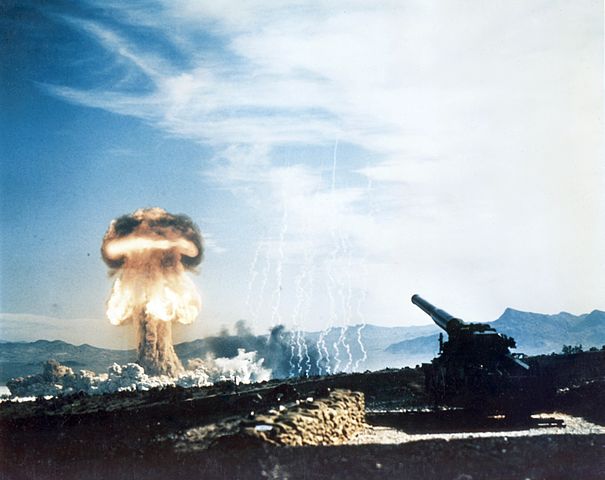
Atomic Annie was the first operational nuclear artillery piece. The 280mm gun was capable of firing a 15 kiloton shell (the same yield as the Nagasaki bomb) out to a distance of up to 20 miles. Though the gun was very large and heavy.
A video of Atomic Annie test.
The United States Military was apparently pleased with the gun, and ordered 20 guns to be produced which were stationed in East Germany, South Korea and on Okinawa in 1953
Alarmed and not be outdone by the capitalists, the Soviet Union reacted quickly to this new weapon, instructing the Grabin design bureau and Kirov design bureaus to design their own nuclear artillery pieces. Not only that, but create a better gun. The Grabin and Kirov bureaus are veteran artillery manufacturers and designers who created guns that continue to serve around the world to this day, so this should have been a simple task, right?
Enter the 2A3 Kondensator
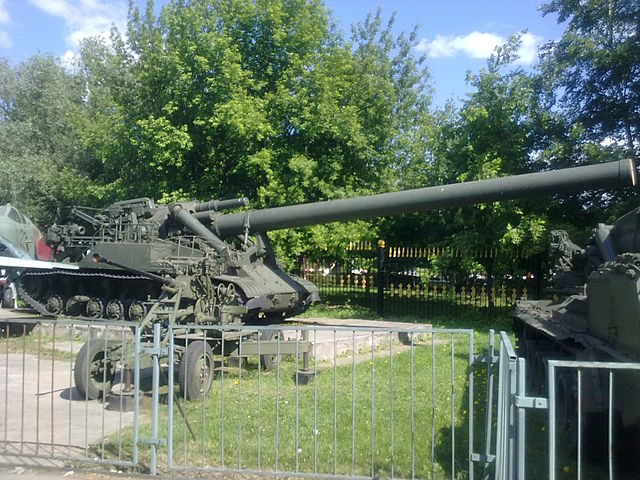
This was the Grabin bureau's design. This colossal gun was self-propelled, unlike the American gun. A considerable advantage The gun's calibre was a colossal 406mm. The vehicle weighed 64 tons. Despite this enormous size it could drive 120 miles and reach a maximum speed of 19 miles an hour.
The gun could indeed fire nuclear shells out to a distance 16 miles. Less than the American gun, and slightly disappointing given the range of the Soviet M-46 130mm field gun was 24 miles, but usable.
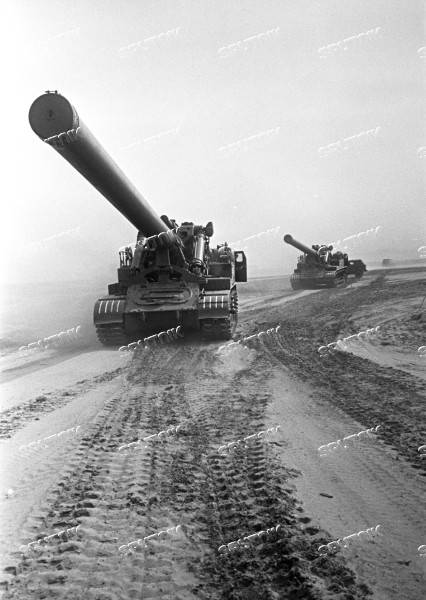
Exercises in proved to be a total fiasco. Due to the enermous weight of the system breakdowns were incredibly common. In addition when firing the gun would roll back about 16 feet. This is not including the somewhat considerable annoyance of the weapon breaking under the force of it's own firepower. Rate of fire was also incredibly poor, being only able to fire a shell every hour. It would likely only fire once before being destroyed in retaliation.
The design would be improved, however, and some of shortcomings such as the gun breaking itself firing would be fixed for the production run.
The Soviets were clearly not too pleased with the design, however. Only 4 were produced for service. They participated in the 1957 May Day parade where foreign observers believed they were mockups for Propaganda purposes.
Work would continue on the design until 1960, when the project was cancelled. One gun can be visited at the Armed Forces Museum in Moscow.
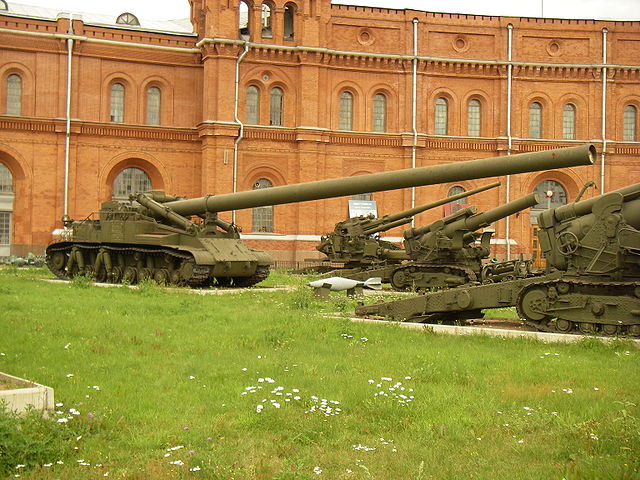
The 2B1 Oka was the Kirov entry. The calibre of the gun was greater than the 2A3, at 420mm. Though the design was lighter at 55 tons.
Unlike the 2A3 Howitzer, the 2B1 Oka was a (breachloading) mortar, measuring a gigantic 65 feet in length. The 2B1 Oka was plagued by much the same issues as the 2A3, it's incredible size damaged the vehicle, and firing was an equally unpleasant affair. A lack of recoil spades ensured even greater recoil than the 2A3.
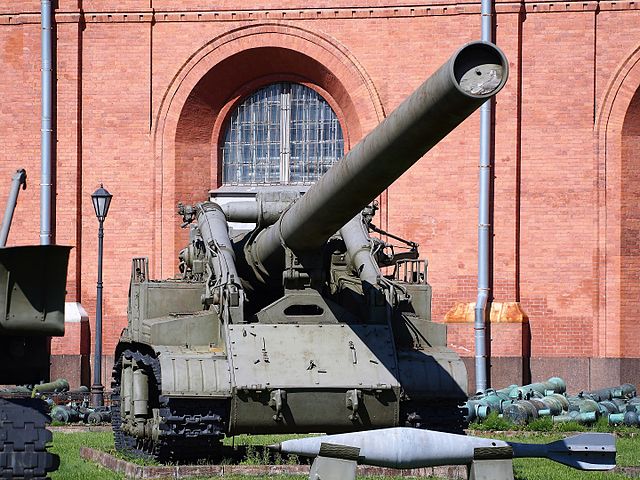
Like the 2A3, 4 examples of the 2B1 were produced. Unlike the previous gun, the Kirov deisgn bureau was never able to fully rectify the issues with the gun and apart from parading in 1957 with the 2A3 the 2B1 never entered service. The project was terminated alongside the 2A3 in 1960. One 2B1 can be visited at the artillery museum in St. Petersburg today.
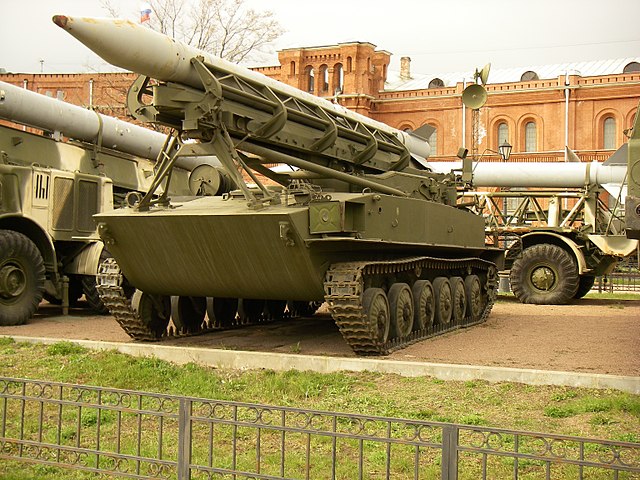
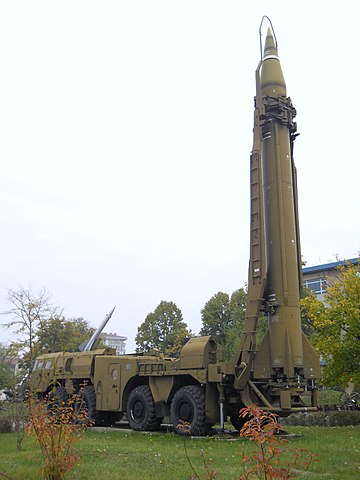
Concurrent with the development of these enormous guns, advances in rocket technology allowed a much more practical method of tactical nuclear weapons delivery for the Soviet Army. The 2K6 Luna rocket would enter service in the Soviet Army in 1960, and the much improved 9K52 Luna-M in 1964. In addition the world famous SCUD missile would enter service in 1957, with the much improved SCUD-B in 1964. A missile which continues to see service to this day.
The 2K6 (and later 9K52) rockets were much more mobile and convenient, as well as allowing greater range and accuracy than the cumbersome guns. They would be deployed at the divisional level with 4 launchers per division.
The SCUD would be deployed at Army and Front level, with 12 and 18 launchers respectively.
This mirrored the United States, who began to phase out the Atomic Annies for the MGR-1 Honest John Rocket. The 4 2A3's would continue in service as part of the STAVKA Artillery Reserve until the mid 1960s before being retired. Thus ends the short life of the Nuclear Monster Guns.
All this work would not be wasted, however. As with the advance in technology came more practical approaches to nuclear artillery. The Soviets would develop the ZBV3 shell, which was compatible with most 152mm calibre artillery pieces in Soviet and Worldwide Communist Service. Shells were also developed for 180mm, 203mm and 240mm pieces. Almost every Soviet Division, Army and Front in Europe would have access to these shells. Nuclear artillery thus would likely play an important role in any "gone hot" scenario in Europe.
The United States however would be less enamoured with gun-fired nuclear artillery. While the W79 shell was common with Corps-level artillery during the Cold War, they cancelled the W82 155mm shell that would analogous to the ZBV3.
The United States and Soviet Union would retire their nuclear shells during the "warm 90s" when the threat of war in Europe diminished with the fall of Communism. A bygone weapon from a bygone age.
Shame they made so few really, it'd be cool to own a nuclear artillery gun
Today we think of nuclear weapons primarily as a strategic weapon and one of deterrence. One that could potentially signal the end of human civilization. While this was also true in the 50s, there was ever increasing interest and exercises conducted with tactical nuclear weapons - weapons intended as just another weapon on the battlefield.
Many different ideas matured, some practical, such as the ubiquitous atomic bomb, others far more strange and questionable, such as the British Blue Peacock nuclear landmine.
Our focus however is artillery.
Modern artillery as we think of it has been common on the battlefield for hundreds of years. In general it has been integral part of warfighting since the crude siege engines of the bronze age. It is doubtful if there has ever been any war that has not featured artillery in some form or another. It is perhaps unsurprising then that Robert Schwartz of the US Picatinny Arsenal came up with the idea for nuclear artillery in 1949.

Atomic Annie was the first operational nuclear artillery piece. The 280mm gun was capable of firing a 15 kiloton shell (the same yield as the Nagasaki bomb) out to a distance of up to 20 miles. Though the gun was very large and heavy.
A video of Atomic Annie test.
The United States Military was apparently pleased with the gun, and ordered 20 guns to be produced which were stationed in East Germany, South Korea and on Okinawa in 1953
Alarmed and not be outdone by the capitalists, the Soviet Union reacted quickly to this new weapon, instructing the Grabin design bureau and Kirov design bureaus to design their own nuclear artillery pieces. Not only that, but create a better gun. The Grabin and Kirov bureaus are veteran artillery manufacturers and designers who created guns that continue to serve around the world to this day, so this should have been a simple task, right?
Enter the 2A3 Kondensator

This was the Grabin bureau's design. This colossal gun was self-propelled, unlike the American gun. A considerable advantage The gun's calibre was a colossal 406mm. The vehicle weighed 64 tons. Despite this enormous size it could drive 120 miles and reach a maximum speed of 19 miles an hour.
The gun could indeed fire nuclear shells out to a distance 16 miles. Less than the American gun, and slightly disappointing given the range of the Soviet M-46 130mm field gun was 24 miles, but usable.

Exercises in proved to be a total fiasco. Due to the enermous weight of the system breakdowns were incredibly common. In addition when firing the gun would roll back about 16 feet. This is not including the somewhat considerable annoyance of the weapon breaking under the force of it's own firepower. Rate of fire was also incredibly poor, being only able to fire a shell every hour. It would likely only fire once before being destroyed in retaliation.
The design would be improved, however, and some of shortcomings such as the gun breaking itself firing would be fixed for the production run.
The Soviets were clearly not too pleased with the design, however. Only 4 were produced for service. They participated in the 1957 May Day parade where foreign observers believed they were mockups for Propaganda purposes.
Work would continue on the design until 1960, when the project was cancelled. One gun can be visited at the Armed Forces Museum in Moscow.

The 2B1 Oka was the Kirov entry. The calibre of the gun was greater than the 2A3, at 420mm. Though the design was lighter at 55 tons.
Unlike the 2A3 Howitzer, the 2B1 Oka was a (breachloading) mortar, measuring a gigantic 65 feet in length. The 2B1 Oka was plagued by much the same issues as the 2A3, it's incredible size damaged the vehicle, and firing was an equally unpleasant affair. A lack of recoil spades ensured even greater recoil than the 2A3.

Like the 2A3, 4 examples of the 2B1 were produced. Unlike the previous gun, the Kirov deisgn bureau was never able to fully rectify the issues with the gun and apart from parading in 1957 with the 2A3 the 2B1 never entered service. The project was terminated alongside the 2A3 in 1960. One 2B1 can be visited at the artillery museum in St. Petersburg today.


Concurrent with the development of these enormous guns, advances in rocket technology allowed a much more practical method of tactical nuclear weapons delivery for the Soviet Army. The 2K6 Luna rocket would enter service in the Soviet Army in 1960, and the much improved 9K52 Luna-M in 1964. In addition the world famous SCUD missile would enter service in 1957, with the much improved SCUD-B in 1964. A missile which continues to see service to this day.
The 2K6 (and later 9K52) rockets were much more mobile and convenient, as well as allowing greater range and accuracy than the cumbersome guns. They would be deployed at the divisional level with 4 launchers per division.
The SCUD would be deployed at Army and Front level, with 12 and 18 launchers respectively.
This mirrored the United States, who began to phase out the Atomic Annies for the MGR-1 Honest John Rocket. The 4 2A3's would continue in service as part of the STAVKA Artillery Reserve until the mid 1960s before being retired. Thus ends the short life of the Nuclear Monster Guns.
All this work would not be wasted, however. As with the advance in technology came more practical approaches to nuclear artillery. The Soviets would develop the ZBV3 shell, which was compatible with most 152mm calibre artillery pieces in Soviet and Worldwide Communist Service. Shells were also developed for 180mm, 203mm and 240mm pieces. Almost every Soviet Division, Army and Front in Europe would have access to these shells. Nuclear artillery thus would likely play an important role in any "gone hot" scenario in Europe.
The United States however would be less enamoured with gun-fired nuclear artillery. While the W79 shell was common with Corps-level artillery during the Cold War, they cancelled the W82 155mm shell that would analogous to the ZBV3.
The United States and Soviet Union would retire their nuclear shells during the "warm 90s" when the threat of war in Europe diminished with the fall of Communism. A bygone weapon from a bygone age.
Shame they made so few really, it'd be cool to own a nuclear artillery gun
fascinating stuff
thanks for sharing
battlefield nukes remain as never used (fine with me)
question as to how big an armored vehicle could be and still be practical
IIRC the nazis had a huge tank or two (maus?). impractical.
Ivan loved his Mayday parades!
interesting to think they were dismissed as fakes
thanks for sharing
battlefield nukes remain as never used (fine with me)
question as to how big an armored vehicle could be and still be practical
IIRC the nazis had a huge tank or two (maus?). impractical.
Ivan loved his Mayday parades!
interesting to think they were dismissed as fakes
originally posted by: ElGoobero
fascinating stuff
thanks for sharing
battlefield nukes remain as never used (fine with me)
question as to how big an armored vehicle could be and still be practical
IIRC the nazis had a huge tank or two (maus?). impractical.
Ivan loved his Mayday parades!
interesting to think they were dismissed as fakes
Cheers!
The Maus was so impractical that it couldn’t cross bridges at the time and to cross rivers it would have to drive into one ans have another Maus push it out. Not sure what they did about the second one...
The 2B1 and 2A3 didn’t weigh that much compared to today, the M1A2 weighs 69 tons i believe, which is on the high side today with tank designs but perfectly usable.
I forgot to mention that the guns were both mounted on a modified chassis of the T-10 Heavy Tank. Many of the more self-destructive issues with them came from the recoil.
Guns of this calibre were typically mounted on Battleships or Railway carriages.
The 2A3’s 406mm gun was the same diameter as that of the guns on the Iowa Class Battleship. Length of gun was about the same as well. The 2B1 Okas 420mm Mortar was even larger. It is remarkable they worked at all on a self-propelled vehicle.
edit on 1012021 by Ohanka because: (no reason
given)
the Iowa Class Battleships had a 16 inch nuclear shell for them.
The W19 nuclear system was adapted into a nuclear artillery shell for the US Navy's 16 inch (406 mm) main battery found on the Iowa-class of battleships, the W23. Production of the W23 began in 1956 and they were in service until 1962, with a total of 50 units being produced.
The W23 was 16 inches (406 mm) in diameter and 64 inches (160 cm) long, with a weight given variously as 1,500 or 1,900 pounds (680 or 860 kg) in reference sources. As with the W19, yield was 15-20 kilotons.
The W19 nuclear system was adapted into a nuclear artillery shell for the US Navy's 16 inch (406 mm) main battery found on the Iowa-class of battleships, the W23. Production of the W23 began in 1956 and they were in service until 1962, with a total of 50 units being produced.
The W23 was 16 inches (406 mm) in diameter and 64 inches (160 cm) long, with a weight given variously as 1,500 or 1,900 pounds (680 or 860 kg) in reference sources. As with the W19, yield was 15-20 kilotons.
What on Earth' tv series episode Amazon's Secret Nightmare 2020. Skyfall the ultimate game changer. Minutes 23-31 Skyfall segment. Curiously the title
of the episode was ‘Amazon’s Secret Nightmare’ the hunt from space for Putin's new mega weapon.
US operates 80+ SkyBirds to closely monitor suspicious activity in hostile nations to see what is going on around planet and most importantly what is the use and purpose of activity. (This episode also mentions 4,000 satellites watching what is happening in and under earth.)
SkyFall is US name for a frightening Russian doomsday nuclear weapon called the Armageddon weapon that can avoid detection and strike any US military base or city. It seems that the Doomsday weapon is now operational
Location of one terrifying nuclear threat has eluded the SkyBirds. In 2018 Russia announced they in middle of developing a nuclear powered cruise missile. In 2018 Russian Putin announced it developing 9M730 Barabanki. The West calls it Skyfall.
On August 8, 2019, accident occurred.
Unlike Americas ballistic missiles it is designed to fly for days without refueling and maneuvers to avoid detection designed to fly low.
Propulsion is a small nuclear reactor stored on board, does not need refueled and can go anywhere it the world at low altitude avoiding detection.
It would give the Russian federation a dramatic upper hand because almost nothing could be done about it. It is undetectable and can go anywhere in the world.
Geolocating was used and they saw Russian Arctic unusual cluster on islands in Bering Sea: pair of rails with environmental shelter and took video and matched it to this site. But Something weird happens, Skyfall disappears, very strange, they were hoping to find another test but they packed up and moved. Scenario is that it is no longer in test phase, it is operational.
Scanning they found a known military cold war launch facility near the White Sea in NW Russia where Russia tested cruise missiles. A section of the base looks suspicious, resembling exactly like the one they saw in the Arctic, a smoking gun
Satellite images reveal Russians have moved to the Russian Navy’s primary launch site.
On Aug 8, 2019 some disturbing news from SkyFall base. Reports are completely confusing. Explosion took place but we dont know what type of explosion and how powerful it is leaving entire international community in dark.
Under pressure, Russian issues a statement finally and say ok there was an accident with a missile test but don’t worry about it
In following days the Russian story unravels, photos on social media showed hazmat suits, ambulances then radiation levels in the area jumped up, a cause for some serious alarm bells. It appears that this Russian super nuclear weapon has spectacularly back fired.
Particularly concerning were reports of stockpiling of iodine in this area which can be used to mitigate or counteract absorption of radiation. In nearby city of 185,000 radiation levels jumped 1500% above normal. Satellite imagery confirms a massive radiation clean up operation underway at the base. Showed pix of a nuclear fuel handler that carries radioactive cargo. Extremely worrying because it looks like they had a major accident.
To cover up extent of the radiation fallout Russia shuts down monitoring stations in the area. The amount of radiation released by Skyfall blast in planet atmosphere remains a mystery for now.
What is alarming: it bears striking similarities to Chernobyl disaster. Russia does not acknowledge it happened; when they do they downplay exposure.
What is certain is that the world has not heard the last of Putin’s Armageddon weapon. A man mentions that Putin has nothing but contempt for its own people. Most of the above was paraphrased.
US operates 80+ SkyBirds to closely monitor suspicious activity in hostile nations to see what is going on around planet and most importantly what is the use and purpose of activity. (This episode also mentions 4,000 satellites watching what is happening in and under earth.)
SkyFall is US name for a frightening Russian doomsday nuclear weapon called the Armageddon weapon that can avoid detection and strike any US military base or city. It seems that the Doomsday weapon is now operational
Location of one terrifying nuclear threat has eluded the SkyBirds. In 2018 Russia announced they in middle of developing a nuclear powered cruise missile. In 2018 Russian Putin announced it developing 9M730 Barabanki. The West calls it Skyfall.
On August 8, 2019, accident occurred.
Unlike Americas ballistic missiles it is designed to fly for days without refueling and maneuvers to avoid detection designed to fly low.
Propulsion is a small nuclear reactor stored on board, does not need refueled and can go anywhere it the world at low altitude avoiding detection.
It would give the Russian federation a dramatic upper hand because almost nothing could be done about it. It is undetectable and can go anywhere in the world.
Geolocating was used and they saw Russian Arctic unusual cluster on islands in Bering Sea: pair of rails with environmental shelter and took video and matched it to this site. But Something weird happens, Skyfall disappears, very strange, they were hoping to find another test but they packed up and moved. Scenario is that it is no longer in test phase, it is operational.
Scanning they found a known military cold war launch facility near the White Sea in NW Russia where Russia tested cruise missiles. A section of the base looks suspicious, resembling exactly like the one they saw in the Arctic, a smoking gun
Satellite images reveal Russians have moved to the Russian Navy’s primary launch site.
On Aug 8, 2019 some disturbing news from SkyFall base. Reports are completely confusing. Explosion took place but we dont know what type of explosion and how powerful it is leaving entire international community in dark.
Under pressure, Russian issues a statement finally and say ok there was an accident with a missile test but don’t worry about it
In following days the Russian story unravels, photos on social media showed hazmat suits, ambulances then radiation levels in the area jumped up, a cause for some serious alarm bells. It appears that this Russian super nuclear weapon has spectacularly back fired.
Particularly concerning were reports of stockpiling of iodine in this area which can be used to mitigate or counteract absorption of radiation. In nearby city of 185,000 radiation levels jumped 1500% above normal. Satellite imagery confirms a massive radiation clean up operation underway at the base. Showed pix of a nuclear fuel handler that carries radioactive cargo. Extremely worrying because it looks like they had a major accident.
To cover up extent of the radiation fallout Russia shuts down monitoring stations in the area. The amount of radiation released by Skyfall blast in planet atmosphere remains a mystery for now.
What is alarming: it bears striking similarities to Chernobyl disaster. Russia does not acknowledge it happened; when they do they downplay exposure.
What is certain is that the world has not heard the last of Putin’s Armageddon weapon. A man mentions that Putin has nothing but contempt for its own people. Most of the above was paraphrased.
edit on America/ChicagoamThu, 25 Feb 2021 01:34:15 -060028011501342America/Chicago by EarthShine because: add lines
originally posted by: ANNED
the Iowa Class Battleships had a 16 inch nuclear shell for them.
The W19 nuclear system was adapted into a nuclear artillery shell for the US Navy's 16 inch (406 mm) main battery found on the Iowa-class of battleships, the W23. Production of the W23 began in 1956 and they were in service until 1962, with a total of 50 units being produced.
The W23 was 16 inches (406 mm) in diameter and 64 inches (160 cm) long, with a weight given variously as 1,500 or 1,900 pounds (680 or 860 kg) in reference sources. As with the W19, yield was 15-20 kilotons.
I did not know that! Thanks for sharing.
I wish i had a nuclear armed bsttleship.
Beautiful piece of weaponry and engineering
The fact cowards ended up getting tactical nukes eliminated burns my rear...how many wars could have been quickly ended by fielding low yield tactical nukes
Vietnam anyone? Korea? Afghanastan/Iraq.
How quick would the enemy have been killed with these, compared to the massive sacrifice of US lives
The fact cowards ended up getting tactical nukes eliminated burns my rear...how many wars could have been quickly ended by fielding low yield tactical nukes
Vietnam anyone? Korea? Afghanastan/Iraq.
How quick would the enemy have been killed with these, compared to the massive sacrifice of US lives
new topics
-
Let's Buy Greenland
General Chit Chat: 23 minutes ago -
Planned Civil War In Britain May Be Triggered Soon
Social Issues and Civil Unrest: 3 hours ago -
Claim: General Mark Milley Approved Heat and Sound Directed Energy Weapons During 2020 Riots
Whistle Blowers and Leaked Documents: 4 hours ago
top topics
-
Claim: General Mark Milley Approved Heat and Sound Directed Energy Weapons During 2020 Riots
Whistle Blowers and Leaked Documents: 4 hours ago, 8 flags -
Planned Civil War In Britain May Be Triggered Soon
Social Issues and Civil Unrest: 3 hours ago, 4 flags -
Let's Buy Greenland
General Chit Chat: 23 minutes ago, 2 flags
active topics
-
January 6th report shows disturbing trend (nobody is shocked)
US Political Madness • 68 • : RazorV66 -
Let's Buy Greenland
General Chit Chat • 2 • : CriticalStinker -
Remember These Attacks When President Trump 2.0 Retribution-Justice Commences.
2024 Elections • 128 • : Oldcarpy2 -
Meta Llama local AI system is scary good
Science & Technology • 44 • : charlyv -
Claim: General Mark Milley Approved Heat and Sound Directed Energy Weapons During 2020 Riots
Whistle Blowers and Leaked Documents • 19 • : Oldcarpy2 -
SC Jack Smith is Using Subterfuge Tricks with Donald Trumps Upcoming Documents Trial.
Dissecting Disinformation • 144 • : matafuchs -
Let's talk planes.
General Chit Chat • 9 • : LetsGoViking -
Gravitic Propulsion--What IF the US and China Really Have it?
General Conspiracies • 27 • : Lazy88 -
Sorry to disappoint you but...
US Political Madness • 38 • : cherokeetroy -
The Truth about Migrant Crime in Britain.
Social Issues and Civil Unrest • 31 • : gortex
17
